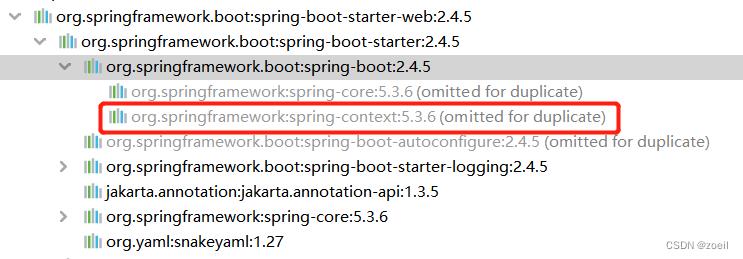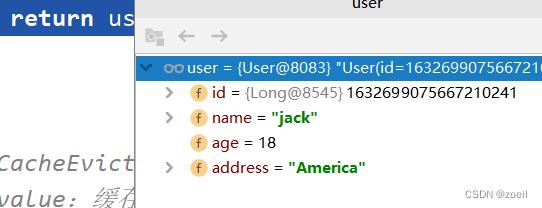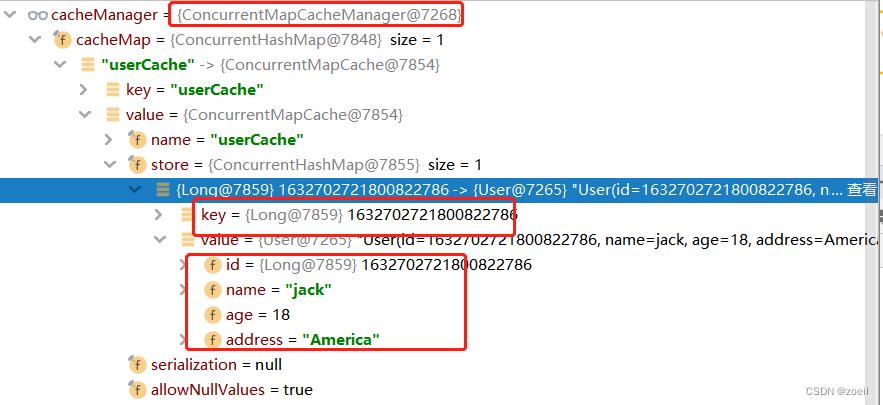Spring Cache简单介绍和使用
Posted zoeil
tags:
篇首语:本文由小常识网(cha138.com)小编为大家整理,主要介绍了Spring Cache简单介绍和使用相关的知识,希望对你有一定的参考价值。
目录
一、简介
Spring Cache是一个框架,实现了基于注解的缓存功能,只需要简单地加一个注解,就能实现缓存功能。
Spring Cache提供了一层抽象,底层可以切换不同的cache实现。具体就是通过CacheManager接口来统一不同的缓存技术。
CacheManager是Spring提供的各种缓存技术抽象接口
针对不同的缓存技术需要实现不同的CacheManager:

CacheManager默认使用的ConcurrentMapManager
Spring Cache 常用注解

在spring boot项目中,使用缓存技术只需在项目中导入相关缓存技术的依赖包,并在启动类上使用@EnableCaching开启缓存支持即可。
例如,使用Redis作为缓存技术,只需要导入Spring data Redis的maven坐标即可。
<dependency>
<groupId>org.springframework.boot</groupId>
<artifactId>spring-boot-starter-data-redis</artifactId>
</dependency>spring cache的基本api在web下的context包中

如果有使用其他的api可以导入cache的依赖
<dependency>
<groupId>org.springframework.boot</groupId>
<artifactId>spring-boot-starter-cache</artifactId>
</dependency>二、使用默认ConcurrentMapManager
(一)创建数据库和表
创建cache_demo数据库,并创建user表
> create database cache_demo;
Query OK, 1 row affected (0.02 sec)
> use cache_demo;
Database changed
> create table user (
> id bigint primary key,
> name varchar(50),
> age int,
> address varchar(50)
>); 
(二)创建boot项目
改POM
<?xml version="1.0" encoding="UTF-8"?>
<project xmlns="http://maven.apache.org/POM/4.0.0"
xmlns:xsi="http://www.w3.org/2001/XMLSchema-instance"
xsi:schemaLocation="http://maven.apache.org/POM/4.0.0 http://maven.apache.org/xsd/maven-4.0.0.xsd">
<modelVersion>4.0.0</modelVersion>
<parent>
<groupId>org.springframework.boot</groupId>
<artifactId>spring-boot-starter-parent</artifactId>
<version>2.4.5</version>
<relativePath/> <!-- lookup parent from repository -->
</parent>
<groupId>com.itheima</groupId>
<artifactId>cache_demo</artifactId>
<version>1.0-SNAPSHOT</version>
<properties>
<java.version>1.8</java.version>
</properties>
<dependencies>
<dependency>
<groupId>org.springframework.boot</groupId>
<artifactId>spring-boot-starter-web</artifactId>
<scope>compile</scope>
</dependency>
<dependency>
<groupId>org.projectlombok</groupId>
<artifactId>lombok</artifactId>
<version>1.18.20</version>
</dependency>
<dependency>
<groupId>com.alibaba</groupId>
<artifactId>fastjson</artifactId>
<version>1.2.76</version>
</dependency>
<dependency>
<groupId>commons-lang</groupId>
<artifactId>commons-lang</artifactId>
<version>2.6</version>
</dependency>
<dependency>
<groupId>org.springframework.boot</groupId>
<artifactId>spring-boot-starter-cache</artifactId>
</dependency>
<dependency>
<groupId>mysql</groupId>
<artifactId>mysql-connector-java</artifactId>
<scope>runtime</scope>
</dependency>
<dependency>
<groupId>com.baomidou</groupId>
<artifactId>mybatis-plus-boot-starter</artifactId>
<version>3.4.2</version>
</dependency>
<dependency>
<groupId>com.alibaba</groupId>
<artifactId>druid-spring-boot-starter</artifactId>
<version>1.1.23</version>
</dependency>
</dependencies>
<build>
<plugins>
<plugin>
<groupId>org.springframework.boot</groupId>
<artifactId>spring-boot-maven-plugin</artifactId>
<version>2.4.5</version>
</plugin>
</plugins>
</build>
</project>写YML
server:
port: 8080
spring:
application:
#应用的名称,可选
name: cache_demo
datasource:
druid:
driver-class-name: com.mysql.cj.jdbc.Driver
url: jdbc:mysql://localhost:3306/cache_demo?serverTimezone=Asia/Shanghai&useUnicode=true&characterEncoding=utf-8&zeroDateTimeBehavior=convertToNull&useSSL=false&allowPublicKeyRetrieval=true
username: root
password: root
mybatis-plus:
configuration:
#在映射实体或者属性时,将数据库中表名和字段名中的下划线去掉,按照驼峰命名法映射
map-underscore-to-camel-case: true
log-impl: org.apache.ibatis.logging.stdout.StdOutImpl
global-config:
db-config:
id-type: ASSIGN_IDUser
@Data
public class User implements Serializable
private static final long serialVersionUID = 1L;
private Long id;
private String name;
private int age;
private String address;
UserMapper
====================================================
@Mapper
public interface UserMapper extends BaseMapper<User>
UserController
====================================================
@RestController
@RequestMapping("/user")
@Slf4j
public class UserController
@Autowired
private UserService userService;
// 增加User
@PostMapping
public User save(User user)
userService.save(user);
return user;
// 删除User
@DeleteMapping("/id")
public void delete(@PathVariable Long id)
userService.removeById(id);
// 更新User
@PutMapping
public User update(User user)
userService.updateById(user);
return user;
// 根据id查询User
@GetMapping("/id")
public User getById(@PathVariable Long id)
User user = userService.getById(id);
return user;
// 根据id和name查询User集合
@GetMapping("/list")
public List<User> list(User user)
LambdaQueryWrapper<User> queryWrapper = new LambdaQueryWrapper<>();
queryWrapper.eq(user.getId() != null,User::getId,user.getId());
queryWrapper.eq(user.getName() != null,User::getName,user.getName());
List<User> list = userService.list(queryWrapper);
return list;
主启动类
@Slf4j
@SpringBootApplication
public class CacheDemoApplication
public static void main(String[] args)
SpringApplication.run(CacheDemoApplication.class,args);
log.info("项目启动成功...");
(三)使用Api
1、@EnableCaching
启动类上加注解@EnableCaching // 使用spring cache
2、@CachePut
// 在controller中加入缓存对象
@Autowired
private CacheManager cacheManager;
/**
* CachePut:将方法返回值放入缓存
* value:缓存的名称,每个缓存名称下面可以有多个key
* key:缓存的key
*/
@CachePut(value = "userCache",key = "#user.id")
@PostMapping
public User save(User user)
userService.save(user);
return user;
通过ctrl点进key下载源码后我们可以看到这里使用的是SpEL语言动态获取值

测试,使用 postman 发请求


第一次添加会将返回的user存放进cacheManager中


3、@cacheable
在方法执行前spring先查看缓存中是否有数据,如果有数据,则直接返回缓存数据;若没有数据,调用方法并将方法返回值放到缓存中
/**
* Cacheable:在方法执行前spring先查看缓存中是否有数据,如果有数据,则直接返回缓存数据;若没有数据,调用方法并将方法返回值放到缓存中
* value:缓存的名称,每个缓存名称下面可以有多个key
* key:缓存的key
* condition:条件,满足条件时才缓存数据
* unless:满足条件则不缓存
*/
@Cacheable(value = "userCache",key = "#id",unless = "#result == null")
@GetMapping("/id")
public User getById(@PathVariable Long id)
User user = userService.getById(id);
return user;
测试,我们使用jack的id去查询一下,同样使用postman,在这个方法设置断点,如果没有触发断点说明是在cache中查询直接返回的
4、@CacheEvict
/**
* CacheEvict:清理指定缓存
* value:缓存的名称,每个缓存名称下面可以有多个key
* key:缓存的key
*/
@CacheEvict(value = "userCache",key = "#p0")
//@CacheEvict(value = "userCache",key = "#root.args[0]")
//@CacheEvict(value = "userCache",key = "#id")
@DeleteMapping("/id")
public void delete(@PathVariable Long id)
userService.removeById(id);
//@CacheEvict(value = "userCache",key = "#p0.id")
//@CacheEvict(value = "userCache",key = "#user.id")
//@CacheEvict(value = "userCache",key = "#root.args[0].id")
@CacheEvict(value = "userCache",key = "#result.id")
@PutMapping
public User update(User user)
userService.updateById(user);
return user;
三、使用redis作为cache
导入redis依赖
<dependency>
<groupId>org.springframework.boot</groupId>
<artifactId>spring-boot-starter-data-redis</artifactId>
</dependency>修改YML
server:
port: 8080
spring:
application:
#应用的名称,可选
name: cache_demo
datasource:
druid:
driver-class-name: com.mysql.cj.jdbc.Driver
url: jdbc:mysql://localhost:3306/cache_demo?serverTimezone=Asia/Shanghai&useUnicode=true&characterEncoding=utf-8&zeroDateTimeBehavior=convertToNull&useSSL=false&allowPublicKeyRetrieval=true
username: root
password: 123456
redis:
host: 192.168.23.100
port: 6379
password: zjy123...000
database: 1
cache:
redis:
time-to-live: 1800000 #设置缓存过期时间,可选
mybatis-plus:
configuration:
#在映射实体或者属性时,将数据库中表名和字段名中的下划线去掉,按照驼峰命名法映射
map-underscore-to-camel-case: true
log-impl: org.apache.ibatis.logging.stdout.StdOutImpl
global-config:
db-config:
id-type: ASSIGN_ID启动项目后,cache变成了RedisCacheManager

使用postman发送save请求

db01

发送DELETE删除缓存


转载Spring Cache介绍
Spring Cache
缓存是实际工作中非常常用的一种提高性能的方法, 我们会在许多场景下来使用缓存。
本文通过一个简单的例子进行展开,通过对比我们原来的自定义缓存和 spring 的基于注释的 cache 配置方法,展现了 spring cache 的强大之处,然后介绍了其基本的原理,扩展点和使用场景的限制。通过阅读本文,你应该可以短时间内掌握 spring 带来的强大缓存技术,在很少的配置下即可给既有代码提供缓存能力。
概述
Spring 3.1 引入了激动人心的基于注释(annotation)的缓存(cache)技术,它本质上不是一个具体的缓存实现方案(例如EHCache 或者 OSCache),而是一个对缓存使用的抽象,通过在既有代码中添加少量它定义的各种 annotation,即能够达到缓存方法的返回对象的效果。
Spring 的缓存技术还具备相当的灵活性,不仅能够使用 SpEL(Spring Expression Language)来定义缓存的 key 和各种 condition,还提供开箱即用的缓存临时存储方案,也支持和主流的专业缓存例如 EHCache 集成。
其特点总结如下:
- 通过少量的配置 annotation 注释即可使得既有代码支持缓存
- 支持开箱即用 Out-Of-The-Box,即不用安装和部署额外第三方组件即可使用缓存
- 支持 Spring Express Language,能使用对象的任何属性或者方法来定义缓存的 key 和 condition
- 支持 AspectJ,并通过其实现任何方法的缓存支持
- 支持自定义 key 和自定义缓存管理者,具有相当的灵活性和扩展性
本文将针对上述特点对 Spring cache 进行详细的介绍,主要通过一个简单的例子和原理介绍展开,然后我们将一起看一个比较实际的缓存例子,最后会介绍 spring cache 的使用限制和注意事项。好吧,让我们开始吧
我们以前如何自己实现缓存的呢
这里先展示一个完全自定义的缓存实现,即不用任何第三方的组件来实现某种对象的内存缓存。
场景如下:
对一个账号查询方法做缓存,以账号名称为 key,账号对象为 value,当以相同的账号名称查询账号的时候,直接从缓存中返回结果,否则更新缓存。账号查询服务还支持 reload 缓存(即清空缓存)
首先定义一个实体类:账号类,具备基本的 id 和 name 属性,且具备 getter 和 setter 方法
public class Account {
private int id;
private String name;
public Account(String name) {
this.name = name;
}
public int getId() {
return id;
}
public void setId(int id) {
this.id = id;
}
public String getName() {
return name;
}
public void setName(String name) {
this.name = name;
}
}
然后定义一个缓存管理器,这个管理器负责实现缓存逻辑,支持对象的增加、修改和删除,支持值对象的泛型。如下:
import com.google.common.collect.Maps;
import java.util.Map;
/**
* @author wenchao.ren
* 2015/1/5.
*/
public class CacheContext<T> {
private Map<String, T> cache = Maps.newConcurrentMap();
public T get(String key){
return cache.get(key);
}
public void addOrUpdateCache(String key,T value) {
cache.put(key, value);
}
// 根据 key 来删除缓存中的一条记录
public void evictCache(String key) {
if(cache.containsKey(key)) {
cache.remove(key);
}
}
// 清空缓存中的所有记录
public void evictCache() {
cache.clear();
}
}
好,现在我们有了实体类和一个缓存管理器,还需要一个提供账号查询的服务类,此服务类使用缓存管理器来支持账号查询缓存,如下:
import com.google.common.base.Optional;
import org.slf4j.Logger;
import org.slf4j.LoggerFactory;
import org.springframework.stereotype.Service;
import javax.annotation.Resource;
/**
* @author wenchao.ren
* 2015/1/5.
*/
@Service
public class AccountService1 {
private final Logger logger = LoggerFactory.getLogger(AccountService1.class);
@Resource
private CacheContext<Account> accountCacheContext;
public Account getAccountByName(String accountName) {
Account result = accountCacheContext.get(accountName);
if (result != null) {
logger.info("get from cache... {}", accountName);
return result;
}
Optional<Account> accountOptional = getFromDB(accountName);
if (!accountOptional.isPresent()) {
throw new IllegalStateException(String.format("can not find account by account name : [%s]", accountName));
}
Account account = accountOptional.get();
accountCacheContext.addOrUpdateCache(accountName, account);
return account;
}
public void reload() {
accountCacheContext.evictCache();
}
private Optional<Account> getFromDB(String accountName) {
logger.info("real querying db... {}", accountName);
//Todo query data from database
return Optional.fromNullable(new Account(accountName));
}
}
现在我们开始写一个测试类,用于测试刚才的缓存是否有效
import org.junit.Before;
import org.junit.Test;
import org.slf4j.Logger;
import org.slf4j.LoggerFactory;
import org.springframework.context.support.ClassPathXmlApplicationContext;
import static org.junit.Assert.*;
public class AccountService1Test {
private AccountService1 accountService1;
private final Logger logger = LoggerFactory.getLogger(AccountService1Test.class);
@Before
public void setUp() throws Exception {
ClassPathXmlApplicationContext context = new ClassPathXmlApplicationContext("applicationContext1.xml");
accountService1 = context.getBean("accountService1", AccountService1.class);
}
@Test
public void testInject(){
assertNotNull(accountService1);
}
@Test
public void testGetAccountByName() throws Exception {
accountService1.getAccountByName("accountName");
accountService1.getAccountByName("accountName");
accountService1.reload();
logger.info("after reload ....");
accountService1.getAccountByName("accountName");
accountService1.getAccountByName("accountName");
}
}
按照分析,执行结果应该是:首先从数据库查询,然后直接返回缓存中的结果,重置缓存后,应该先从数据库查询,然后返回缓存中的结果. 查看程序运行的日志如下:
00:53:17.166 [main] INFO c.r.s.cache.example1.AccountService - real querying db... accountName
00:53:17.168 [main] INFO c.r.s.cache.example1.AccountService - get from cache... accountName
00:53:17.168 [main] INFO c.r.s.c.example1.AccountServiceTest - after reload ....
00:53:17.168 [main] INFO c.r.s.cache.example1.AccountService - real querying db... accountName
00:53:17.169 [main] INFO c.r.s.cache.example1.AccountService - get from cache... accountName
可以看出我们的缓存起效了,但是这种自定义的缓存方案有如下劣势:
- 缓存代码和业务代码耦合度太高,如上面的例子,AccountService 中的 getAccountByName()方法中有了太多缓存的逻辑,不便于维护和变更
- 不灵活,这种缓存方案不支持按照某种条件的缓存,比如只有某种类型的账号才需要缓存,这种需求会导致代码的变更
- 缓存的存储这块写的比较死,不能灵活的切换为使用第三方的缓存模块
如果你的代码中有上述代码的影子,那么你可以考虑按照下面的介绍来优化一下你的代码结构了,也可以说是简化,你会发现,你的代码会变得优雅的多!
Spring cache是如何做的呢
我们对AccountService1 进行修改,创建AccountService2:
import com.google.common.base.Optional;
import com.rollenholt.spring.cache.example1.Account;
import org.slf4j.Logger;
import org.slf4j.LoggerFactory;
import org.springframework.cache.annotation.Cacheable;
import org.springframework.stereotype.Service;
/**
* @author wenchao.ren
* 2015/1/5.
*/
@Service
public class AccountService2 {
private final Logger logger = LoggerFactory.getLogger(AccountService2.class);
// 使用了一个缓存名叫 accountCache
@Cacheable(value="accountCache")
public Account getAccountByName(String accountName) {
// 方法内部实现不考虑缓存逻辑,直接实现业务
logger.info("real querying account... {}", accountName);
Optional<Account> accountOptional = getFromDB(accountName);
if (!accountOptional.isPresent()) {
throw new IllegalStateException(String.format("can not find account by account name : [%s]", accountName));
}
return accountOptional.get();
}
private Optional<Account> getFromDB(String accountName) {
logger.info("real querying db... {}", accountName);
//Todo query data from database
return Optional.fromNullable(new Account(accountName));
}
}
我们注意到在上面的代码中有一行:
@Cacheable(value="accountCache")
这个注释的意思是,当调用这个方法的时候,会从一个名叫 accountCache 的缓存中查询,如果没有,则执行实际的方法(即查询数据库),并将执行的结果存入缓存中,否则返回缓存中的对象。这里的缓存中的 key 就是参数 accountName,value 就是 Account 对象。“accountCache”缓存是在 spring*.xml 中定义的名称。我们还需要一个 spring 的配置文件来支持基于注释的缓存
<beans xmlns="http://www.springframework.org/schema/beans"
xmlns:xsi="http://www.w3.org/2001/XMLSchema-instance"
xmlns:context="http://www.springframework.org/schema/context"
xmlns:cache="http://www.springframework.org/schema/cache"
xsi:schemaLocation="http://www.springframework.org/schema/beans
http://www.springframework.org/schema/beans/spring-beans.xsd
http://www.springframework.org/schema/context
http://www.springframework.org/schema/context/spring-context.xsd
http://www.springframework.org/schema/cache
http://www.springframework.org/schema/cache/spring-cache.xsd">
<context:component-scan base-package="com.rollenholt.spring.cache"/>
<context:annotation-config/>
<cache:annotation-driven/>
<bean id="cacheManager" class="org.springframework.cache.support.SimpleCacheManager">
<property name="caches">
<set>
<bean class="org.springframework.cache.concurrent.ConcurrentMapCacheFactoryBean">
<property name="name" value="default"/>
</bean>
<bean class="org.springframework.cache.concurrent.ConcurrentMapCacheFactoryBean">
<property name="name" value="accountCache"/>
</bean>
</set>
</property>
</bean>
</beans>
注意这个 spring 配置文件有一个关键的支持缓存的配置项:
<cache:annotation-driven />
这个配置项缺省使用了一个名字叫 cacheManager 的缓存管理器,这个缓存管理器有一个 spring 的缺省实现,即 org.springframework.cache.support.SimpleCacheManager,这个缓存管理器实现了我们刚刚自定义的缓存管理器的逻辑,它需要配置一个属性 caches,即此缓存管理器管理的缓存集合,除了缺省的名字叫 default 的缓存,我们还自定义了一个名字叫 accountCache 的缓存,使用了缺省的内存存储方案 ConcurrentMapCacheFactoryBean,它是基于 java.util.concurrent.ConcurrentHashMap 的一个内存缓存实现方案。
然后我们编写测试程序:
import org.junit.Before;
import org.junit.Test;
import org.slf4j.Logger;
import org.slf4j.LoggerFactory;
import org.springframework.context.support.ClassPathXmlApplicationContext;
import static org.junit.Assert.*;
public class AccountService2Test {
private AccountService2 accountService2;
private final Logger logger = LoggerFactory.getLogger(AccountService2Test.class);
@Before
public void setUp() throws Exception {
ClassPathXmlApplicationContext context = new ClassPathXmlApplicationContext("applicationContext2.xml");
accountService2 = context.getBean("accountService2", AccountService2.class);
}
@Test
public void testInject(){
assertNotNull(accountService2);
}
@Test
public void testGetAccountByName() throws Exception {
logger.info("first query...");
accountService2.getAccountByName("accountName");
logger.info("second query...");
accountService2.getAccountByName("accountName");
}
}
上面的测试代码主要进行了两次查询,第一次应该会查询数据库,第二次应该返回缓存,不再查数据库,我们执行一下,看看结果
01:10:32.435 [main] INFO c.r.s.c.example2.AccountService2Test - first query...
01:10:32.456 [main] INFO c.r.s.cache.example2.AccountService2 - real querying account... accountName
01:10:32.457 [main] INFO c.r.s.cache.example2.AccountService2 - real querying db... accountName
01:10:32.458 [main] INFO c.r.s.c.example2.AccountService2Test - second query...
可以看出我们设置的基于注释的缓存起作用了,而在 AccountService.java 的代码中,我们没有看到任何的缓存逻辑代码,只有一行注释:@Cacheable(value="accountCache"),就实现了基本的缓存方案,是不是很强大?
如何清空缓存
好,到目前为止,我们的 spring cache 缓存程序已经运行成功了,但是还不完美,因为还缺少一个重要的缓存管理逻辑:清空缓存.
当账号数据发生变更,那么必须要清空某个缓存,另外还需要定期的清空所有缓存,以保证缓存数据的可靠性。
为了加入清空缓存的逻辑,我们只要对 AccountService2.java 进行修改,从业务逻辑的角度上看,它有两个需要清空缓存的地方
- 当外部调用更新了账号,则我们需要更新此账号对应的缓存
- 当外部调用说明重新加载,则我们需要清空所有缓存
我们在AccountService2的基础上进行修改,修改为AccountService3,代码如下:
import com.google.common.base.Optional;
import com.rollenholt.spring.cache.example1.Account;
import org.slf4j.Logger;
import org.slf4j.LoggerFactory;
import org.springframework.cache.annotation.CacheEvict;
import org.springframework.cache.annotation.Cacheable;
import org.springframework.stereotype.Service;
/**
* @author wenchao.ren
* 2015/1/5.
*/
@Service
public class AccountService3 {
private final Logger logger = LoggerFactory.getLogger(AccountService3.class);
// 使用了一个缓存名叫 accountCache
@Cacheable(value="accountCache")
public Account getAccountByName(String accountName) {
// 方法内部实现不考虑缓存逻辑,直接实现业务
logger.info("real querying account... {}", accountName);
Optional<Account> accountOptional = getFromDB(accountName);
if (!accountOptional.isPresent()) {
throw new IllegalStateException(String.format("can not find account by account name : [%s]", accountName));
}
return accountOptional.get();
}
@CacheEvict(value="accountCache",key="#account.getName()")
public void updateAccount(Account account) {
updateDB(account);
}
@CacheEvict(value="accountCache",allEntries=true)
public void reload() {
}
private void updateDB(Account account) {
logger.info("real update db...{}", account.getName());
}
private Optional<Account> getFromDB(String accountName) {
logger.info("real querying db... {}", accountName);
//Todo query data from database
return Optional.fromNullable(new Account(accountName));
}
}
我们的测试代码如下:
import com.rollenholt.spring.cache.example1.Account;
import org.junit.Before;
import org.junit.Test;
import org.slf4j.Logger;
import org.slf4j.LoggerFactory;
import org.springframework.context.support.ClassPathXmlApplicationContext;
public class AccountService3Test {
private AccountService3 accountService3;
private final Logger logger = LoggerFactory.getLogger(AccountService3Test.class);
@Before
public void setUp() throws Exception {
ClassPathXmlApplicationContext context = new ClassPathXmlApplicationContext("applicationContext2.xml");
accountService3 = context.getBean("accountService3", AccountService3.class);
}
@Test
public void testGetAccountByName() throws Exception {
logger.info("first query.....");
accountService3.getAccountByName("accountName");
logger.info("second query....");
accountService3.getAccountByName("accountName");
}
@Test
public void testUpdateAccount() throws Exception {
Account account1 = accountService3.getAccountByName("accountName1");
logger.info(account1.toString());
Account account2 = accountService3.getAccountByName("accountName2");
logger.info(account2.toString());
account2.setId(121212);
accountService3.updateAccount(account2);
// account1会走缓存
account1 = accountService3.getAccountByName("accountName1");
logger.info(account1.toString());
// account2会查询db
account2 = accountService3.getAccountByName("accountName2");
logger.info(account2.toString());
}
@Test
public void testReload() throws Exception {
accountService3.reload();
// 这2行查询数据库
accountService3.getAccountByName("somebody1");
accountService3.getAccountByName("somebody2");
// 这两行走缓存
accountService3.getAccountByName("somebody1");
accountService3.getAccountByName("somebody2");
}
}
在这个测试代码中我们重点关注testUpdateAccount()方法,在测试代码中我们已经注释了在update完account2以后,再次查询的时候,account1会走缓存,而account2不会走缓存,而去查询db,观察程序运行日志,运行日志为:
01:37:34.549 [main] INFO c.r.s.cache.example3.AccountService3 - real querying account... accountName1
01:37:34.551 [main] INFO c.r.s.cache.example3.AccountService3 - real querying db... accountName1
01:37:34.552 [main] INFO c.r.s.c.example3.AccountService3Test - Account{id=0, name=\'accountName1\'}
01:37:34.553 [main] INFO c.r.s.cache.example3.AccountService3 - real querying account... accountName2
01:37:34.553 [main] INFO c.r.s.cache.example3.AccountService3 - real querying db... accountName2
01:37:34.555 [main] INFO c.r.s.c.example3.AccountService3Test - Account{id=0, name=\'accountName2\'}
01:37:34.555 [main] INFO c.r.s.cache.example3.AccountService3 - real update db...accountName2
01:37:34.595 [main] INFO c.r.s.c.example3.AccountService3Test - Account{id=0, name=\'accountName1\'}
01:37:34.596 [main] INFO c.r.s.cache.example3.AccountService3 - real querying account... accountName2
01:37:34.596 [main] INFO c.r.s.cache.example3.AccountService3 - real querying db... accountName2
01:37:34.596 [main] INFO c.r.s.c.example3.AccountService3Test - Account{id=0, name=\'accountName2\'}
我们会发现实际运行情况和我们预估的结果是一致的。
如何按照条件操作缓存
前面介绍的缓存方法,没有任何条件,即所有对 accountService 对象的 getAccountByName 方法的调用都会起动缓存效果,不管参数是什么值。
如果有一个需求,就是只有账号名称的长度小于等于 4 的情况下,才做缓存,大于 4 的不使用缓存
虽然这个需求比较坑爹,但是抛开需求的合理性,我们怎么实现这个功能呢?
通过查看CacheEvict注解的定义,我们会发现:
/**
* Annotation indicating that a method (or all methods on a class) trigger(s)
* a cache invalidate operation.
*
* @author Costin Leau
* @author Stephane Nicoll
* @since 3.1
* @see CacheConfig
*/
@Target({ElementType.METHOD, ElementType.TYPE})
@Retention(RetentionPolicy.RUNTIME)
@Inherited
@Documented
public @interface CacheEvict {
/**
* Qualifier value for the specified cached operation.
* <p>May be used to determine the target cache (or caches), matching the qualifier
* value (or the bean name(s)) of (a) specific bean definition.
*/
String[] value() default {};
/**
* Spring Expression Language (SpEL) attribute for computing the key dynamically.
* <p>Default is "", meaning all method parameters are considered as a key, unless
* a custom {@link #keyGenerator()} has been set.
*/
String key() default "";
/**
* The bean name of the custom {@link org.springframework.cache.interceptor.KeyGenerator} to use.
* <p>Mutually exclusive with the {@link #key()} attribute.
*/
String keyGenerator() default "";
/**
* The bean name of the custom {@link org.springframework.cache.CacheManager} to use to
* create a default {@link org.springframework.cache.interceptor.CacheResolver} if none
* is set already.
* <p>Mutually exclusive with the {@link #cacheResolver()} attribute.
* @see org.springframework.cache.interceptor.SimpleCacheResolver
*/
String cacheManager() default "";
/**
* The bean name of the custom {@link org.springframework.cache.interceptor.CacheResolver} to use.
*/
String cacheResolver() default "";
/**
* Spring Expression Language (SpEL) attribute used for conditioning the method caching.
* <p>Default is "", meaning the method is always cached.
*/
String condition() default "";
/**
* Whether or not all the entries inside the cache(s) are removed or not. By
* default, only the value under the associated key is removed.
* <p>Note that setting this parameter to {@code true} and specifying a {@link #key()}
* is not allowed.
*/
boolean allEntries() default false;
/**
* Whether the eviction should occur after the method is successfully invoked (default)
* or before. The latter causes the eviction to occur irrespective of the method outcome (whether
* it threw an exception or not) while the former does not.
*/
boolean beforeInvocation() default false;
}
定义中有一个condition描述:
Spring Expression Language (SpEL) attribute used for conditioning the method caching.Default is "", meaning the method is always cached.
我们可以利用这个方法来完成这个功能,下面只给出示例代码:
@Cacheable(value="accountCache",condition="#accountName.length() <= 4")// 缓存名叫 accountCache
public Account getAccountByName(String accountName) {
// 方法内部实现不考虑缓存逻辑,直接实现业务
return getFromDB(accountName);
}
注意其中的 condition=”#accountName.length() <=4”,这里使用了 SpEL 表达式访问了参数 accountName 对象的 length() 方法,条件表达式返回一个布尔值,true/false,当条件为 true,则进行缓存操作,否则直接调用方法执行的返回结果。
如果有多个参数,如何进行 key 的组合
我们看看CacheEvict注解的key()方法的描述:
Spring Expression Language (SpEL) attribute for computing the key dynamically. Default is "", meaning all method parameters are considered as a key, unless a custom {@link #keyGenerator()} has been set.
假设我们希望根据对象相关属性的组合来进行缓存,比如有这么一个场景:
要求根据账号名、密码和是否发送日志查询账号信息
很明显,这里我们需要根据账号名、密码对账号对象进行缓存,而第三个参数“是否发送日志”对缓存没有任何影响。所以,我们可以利用 SpEL 表达式对缓存 key 进行设计
我们为Account类增加一个password 属性, 然后修改AccountService代码:
@Cacheable(value="accountCache",key="#accountName.concat(#password)")
public Account getAccount(String accountName,String password,boolean sendLog) {
// 方法内部实现不考虑缓存逻辑,直接实现业务
return getFromDB(accountName,password);
}
注意上面的 key 属性,其中引用了方法的两个参数 accountName 和 password,而 sendLog 属性没有考虑,因为其对缓存没有影响。
accountService.getAccount("accountName", "123456", true);// 查询数据库
accountService.getAccount("accountName", "123456", true);// 走缓存
accountService.getAccount("accountName", "123456", false);// 走缓存
accountService.getAccount("accountName", "654321", true);// 查询数据库
accountService.getAccount("accountName", "654321", true);// 走缓存
如何做到:既要保证方法被调用,又希望结果被缓存
根据前面的例子,我们知道,如果使用了 @Cacheable 注释,则当重复使用相同参数调用方法的时候,方法本身不会被调用执行,即方法本身被略过了,取而代之的是方法的结果直接从缓存中找到并返回了。
现实中并不总是如此,有些情况下我们希望方法一定会被调用,因为其除了返回一个结果,还做了其他事情,例如记录日志,调用接口等,这个时候,我们可以用 @CachePut 注释,这个注释可以确保方法被执行,同时方法的返回值也被记录到缓存中。
@Cacheable(value="accountCache")
public Account getAccountByName(String accountName) {
// 方法内部实现不考虑缓存逻辑,直接实现业务
return getFromDB(accountName);
}
// 更新 accountCache 缓存
@CachePut(value="accountCache",key="#account.getName()")
public Account updateAccount(Account account) {
return updateDB(account);
}
private Account updateDB(Account account) {
logger.info("real updating db..."+account.getName());
return account;
}
我们的测试代码如下
Account account = accountService.getAccountByName("someone");
account.setPassword("123");
accountService.updateAccount(account);
account.setPassword("321");
accountService.updateAccount(account);
account = accountService.getAccountByName("someone");
logger.info(account.getPassword());
如上面的代码所示,我们首先用 getAccountByName 方法查询一个人 someone 的账号,这个时候会查询数据库一次,但是也记录到缓存中了。然后我们修改了密码,调用了 updateAccount 方法,这个时候会执行数据库的更新操作且记录到缓存,我们再次修改密码并调用 updateAccount 方法,然后通过 getAccountByName 方法查询,这个时候,由于缓存中已经有数据,所以不会查询数据库,而是直接返回最新的数据,所以打印的密码应该是“321”
@Cacheable、@CachePut、@CacheEvict 注释介绍
- @Cacheable 主要针对方法配置,能够根据方法的请求参数对其结果进行缓存
- @CachePut 主要针对方法配置,能够根据方法的请求参数对其结果进行缓存,和 @Cacheable 不同的是,它每次都会触发真实方法的调用
-@CachEvict 主要针对方法配置,能够根据一定的条件对缓存进行清空
基本原理
一句话介绍就是Spring AOP的动态代理技术。 如果读者对Spring AOP不熟悉的话,可以去看看官方文档
扩展性
直到现在,我们已经学会了如何使用开箱即用的 spring cache,这基本能够满足一般应用对缓存的需求。
但现实总是很复杂,当你的用户量上去或者性能跟不上,总需要进行扩展,这个时候你或许对其提供的内存缓存不满意了,因为其不支持高可用性,也不具备持久化数据能力,这个时候,你就需要自定义你的缓存方案了。
还好,spring 也想到了这一点。我们先不考虑如何持久化缓存,毕竟这种第三方的实现方案很多。
我们要考虑的是,怎么利用 spring 提供的扩展点实现我们自己的缓存,且在不改原来已有代码的情况下进行扩展。
首先,我们需要提供一个 CacheManager 接口的实现,这个接口告诉 spring 有哪些 cache 实例,spring 会根据 cache 的名字查找 cache 的实例。另外还需要自己实现 Cache 接口,Cache 接口负责实际的缓存逻辑,例如增加键值对、存储、查询和清空等。
利用 Cache 接口,我们可以对接任何第三方的缓存系统,例如 EHCache、OSCache,甚至一些内存数据库例如 memcache 或者 redis 等。下面我举一个简单的例子说明如何做。
import java.util.Collection;
import org.springframework.cache.support.AbstractCacheManager;
public class MyCacheManager extends AbstractCacheManager {
private Collection<? extends MyCache> caches;
/**
* Specify the collection of Cache instances to use for this CacheManager.
*/
public void setCaches(Collection<? extends MyCache> caches) {
this.caches = caches;
}
@Override
protected Collection<? extends MyCache> loadCaches() {
return this.caches;
}
}
上面的自定义的 CacheManager 实际继承了 spring 内置的 AbstractCacheManager,实际上仅仅管理 MyCache 类的实例。
下面是MyCache的定义:
import java.util.HashMap;
import java.util.Map;
import org.springframework.cache.Cache;
import org.springframework.cache.support.SimpleValueWrapper;
public class MyCache implements Cache {
private String name;
private Map<String,Account> store = new HashMap<String,Account>();;
public MyCache() {
}
public MyCache(String name) {
this.name = name;
}
@Override
public String getName() {
return name;
}
public void setName(String name) {
this.name = name;
}
@Override
public Object getNativeCache() {
return store;
}
@Override
public ValueWrapper get(Object key) {
ValueWrapper result = null;
Account thevalue = store.get(key);
if(thevalue!=null) {
thevalue.setPassword("from mycache:"+name);
result = new SimpleValueWrapper(thevalue);
}
return result;
}
@Override
public void put(Object key, Object value) {
Account thevalue = (Account)value;
store.put((String)key, thevalue);
}
@Override
public void evict(Object key) {
}
@Override
public void clear() {
}
}
上面的自定义缓存只实现了很简单的逻辑,但这是我们自己做的,也很令人激动是不是,主要看 get 和 put 方法,其中的 get 方法留了一个后门,即所有的从缓存查询返回的对象都将其 password 字段设置为一个特殊的值,这样我们等下就能演示“我们的缓存确实在起作用!”了。
这还不够,spring 还不知道我们写了这些东西,需要通过 spring*.xml 配置文件告诉它
<cache:annotation-driven />
<bean id="cacheManager" class="com.rollenholt.spring.cache.MyCacheManager">
<property name="caches">
<set>
<bean
class="com.rollenholt.spring.cache.MyCache"
p:name="accountCache" />
</set>
</property>
</bean>
接下来我们来编写测试代码:
Account account = accountService.getAccountByName("someone");
logger.info("passwd={}", account.getPassword());
account = accountService.getAccountByName("someone");
logger.info("passwd={}", account.getPassword());
上面的测试代码主要是先调用 getAccountByName 进行一次查询,这会调用数据库查询,然后缓存到 mycache 中,然后我打印密码,应该是空的;下面我再次查询 someone 的账号,这个时候会从 mycache 中返回缓存的实例,记得上面的后门么?我们修改了密码,所以这个时候打印的密码应该是一个特殊的值
注意和限制
基于 proxy 的 spring aop 带来的内部调用问题
上面介绍过 spring cache 的原理,即它是基于动态生成的 proxy 代理机制来对方法的调用进行切面,这里关键点是对象的引用问题.
如果对象的方法是内部调用(即 this 引用)而不是外部引用,则会导致 proxy 失效,那么我们的切面就失效,也就是说上面定义的各种注释包括 @Cacheable、@CachePut 和 @CacheEvict 都会失效,我们来演示一下。
public Account getAccountByName2(String accountName) {
return this.getAccountByName(accountName);
}
@Cacheable(value="accountCache")// 使用了一个缓存名叫 accountCache
public Account getAccountByName(String accountName) {
// 方法内部实现不考虑缓存逻辑,直接实现业务
return getFromDB(accountName);
}
上面我们定义了一个新的方法 getAccountByName2,其自身调用了 getAccountByName 方法,这个时候,发生的是内部调用(this),所以没有走 proxy,导致 spring cache 失效
要避免这个问题,就是要避免对缓存方法的内部调用,或者避免使用基于 proxy 的 AOP 模式,可以使用基于 aspectJ 的 AOP 模式来解决这个问题。
@CacheEvict 的可靠性问题
我们看到,@CacheEvict 注释有一个属性 beforeInvocation,缺省为 false,即缺省情况下,都是在实际的方法执行完成后,才对缓存进行清空操作。期间如果执行方法出现异常,则会导致缓存清空不被执行。我们演示一下
// 清空 accountCache 缓存
@CacheEvict(value="accountCache",allEntries=true)
public void reload() {
throw new RuntimeException();
}
我们的测试代码如下:
accountService.getAccountByName("someone");
accountService.getAccountByName("someone");
try {
accountService.reload();
} catch (Exception e) {
//...
}
accountService.getAccountByName("someone");
注意上面的代码,我们在 reload 的时候抛出了运行期异常,这会导致清空缓存失败。上面的测试代码先查询了两次,然后 reload,然后再查询一次,结果应该是只有第一次查询走了数据库,其他两次查询都从缓存,第三次也走缓存因为 reload 失败了。
那么我们如何避免这个问题呢?我们可以用 @CacheEvict 注释提供的 beforeInvocation 属性,将其设置为 true,这样,在方法执行前我们的缓存就被清空了。可以确保缓存被清空。
非 public 方法问题
和内部调用问题类似,非 public 方法如果想实现基于注释的缓存,必须采用基于 AspectJ 的 AOP 机制
Dummy CacheManager 的配置和作用
有的时候,我们在代码迁移、调试或者部署的时候,恰好没有 cache 容器,比如 memcache 还不具备条件,h2db 还没有装好等,如果这个时候你想调试代码,岂不是要疯掉?这里有一个办法,在不具备缓存条件的时候,在不改代码的情况下,禁用缓存。
方法就是修改 spring*.xml 配置文件,设置一个找不到缓存就不做任何操作的标志位,如下
<cache:annotation-driven />
<bean id="simpleCacheManager" class="org.springframework.cache.support.SimpleCacheManager">
<property name="caches">
<set>
<bean
class="org.springframework.cache.concurrent.ConcurrentMapCacheFactoryBean"
p:name="default" />
</set>
</property>
</bean>
<bean id="cacheManager" class="org.springframework.cache.support.CompositeCacheManager">
<property name="cacheManagers">
<list>
<ref bean="simpleCacheManager" />
</list>
</property>
<property name="fallbackToNoOpCache" value="true" />
</bean>
注意以前的 cacheManager 变为了 simpleCacheManager,且没有配置 accountCache 实例,后面的 cacheManager 的实例是一个 CompositeCacheManager,他利用了前面的 simpleCacheManager 进行查询,如果查询不到,则根据标志位 fallbackToNoOpCache 来判断是否不做任何缓存操作。
使用 guava cache
<bean id="cacheManager" class="org.springframework.cache.guava.GuavaCacheManager">
<property name="cacheSpecification" value="concurrencyLevel=4,expireAfterAccess=100s,expireAfterWrite=100s" />
<property name="cacheNames">
<list>
<value>dictTableCache</value>
</list>
</property>
</bean>
代码地址:
https://github.com/rollenholt/spring-cache-example
以上是关于Spring Cache简单介绍和使用的主要内容,如果未能解决你的问题,请参考以下文章